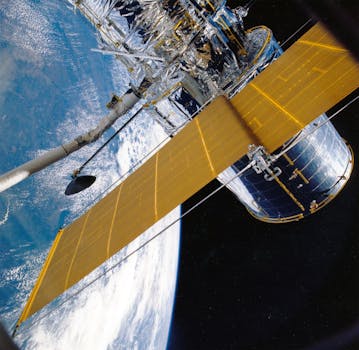GEO Satellites: Understanding the Technology and Its Applications – GEO Satellites

GEO Satellites: Introduction to the Technology – GEO Satellites
GEO satellites, or Geostationary Earth Orbit satellites, are a type of satellite that orbits the Earth at an altitude of approximately 36,000 kilometers. At this altitude, the satellite’s orbital period matches the Earth’s rotational period, allowing it to remain stationary relative to a fixed point on the Earth’s surface. This unique characteristic makes GEO satellites ideal for providing global coverage and enabling a wide range of applications, including telecommunications, weather forecasting, and navigation.
The technology behind GEO satellites is complex and involves a range of components, including the satellite itself, the launch vehicle, and the ground control systems. The satellite is equipped with a range of instruments, including transponders, antennas, and solar panels, which enable it to receive and transmit signals, as well as generate power. The launch vehicle is responsible for carrying the satellite into orbit, while the ground control systems monitor and control the satellite’s operations.
Applications of GEO Satellites
GEO satellites have a wide range of applications, including telecommunications, weather forecasting, and navigation. In the field of telecommunications, GEO satellites are used to provide global coverage, enabling users to communicate with each other from anywhere in the world. They are also used to broadcast television channels, providing entertainment and news to millions of people around the world.
In addition to telecommunications, GEO satellites are also used for weather forecasting and navigation. They are equipped with instruments that can detect changes in the Earth’s atmosphere and oceans, providing valuable data for weather forecasting and climate modeling. They are also used for navigation, providing location information and timing signals that enable GPS systems to function.
Benefits and Challenges of GEO Satellites
GEO satellites offer a range of benefits, including global coverage, high bandwidth, and reliability. They are also relatively low maintenance, as they can operate for many years without the need for refurbishment or replacement. However, they also present several challenges, including the high cost of launch and operation, as well as the risk of interference from other satellites and terrestrial systems.
Despite these challenges, GEO satellites remain a crucial part of modern telecommunications, providing global coverage and enabling a wide range of applications. As technology continues to evolve, we can expect to see new and innovative uses for GEO satellites, including the provision of high-speed internet access and the support of emerging technologies such as the Internet of Things (IoT).
Conclusion
In conclusion, GEO satellites are a vital part of modern telecommunications, providing global coverage and enabling a wide range of applications. While they present several challenges, including the high cost of launch and operation, they offer many benefits, including high bandwidth, reliability, and low maintenance. As technology continues to evolve, we can expect to see new and innovative uses for GEO satellites, supporting emerging technologies and enabling new applications.



